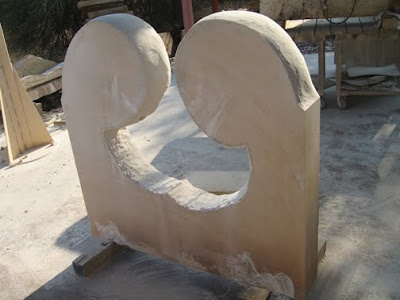
Remember this?
After the diversion of going to a quarry, I’m back to work on this fountain. Having drilled the mounting and water holes, the next step is to remove the remaining stone between the heads and then refine the shapes. I used an air hammer and chisels to cut away the stone. The picture below is part way through the removal process. Notice that stone has been carved away from the backs of the heads as well as from between them. You can also see how rough the surface is from the chiseling … and what a mess it makes. This is one reason I work outside and not inside the studio.
 In this photo all of the bulk stone has been removed and we are ready to start refining the shapes and smoothing with diamond grinding wheels and silicon carbide grinding pads on an electric grinder. Stone sculpture is a process of making finer and finer marks – you start with deep gouges made with chisels, remove then with scrapes made by grinding pads, and finish by removing the scrapes with scratches made with sandpaper or diamond pads. Because the scratches are so fine that your eye doesn’t see them, the surface looks polished, but it really covered with incredibly fine scratches.
In this photo all of the bulk stone has been removed and we are ready to start refining the shapes and smoothing with diamond grinding wheels and silicon carbide grinding pads on an electric grinder. Stone sculpture is a process of making finer and finer marks – you start with deep gouges made with chisels, remove then with scrapes made by grinding pads, and finish by removing the scrapes with scratches made with sandpaper or diamond pads. Because the scratches are so fine that your eye doesn’t see them, the surface looks polished, but it really covered with incredibly fine scratches. 
Here I’ve started shaping the heads doing the first-pass grinding and you can see how smooth they are compared to the chiseled space below them. But, if you look closely you can see that the heads aren’t really smooth – they have lots of flat spots, ridges, grinder marks, and some chisel marks that are still visible.
In the photo below, I’ve started smoothing the bodies and you can see a grinder with a curved diamond grinding wheel. Notice the big chunk missing from the head on the right? That’s the next challenge – how to make it disappear or fit into the design.












